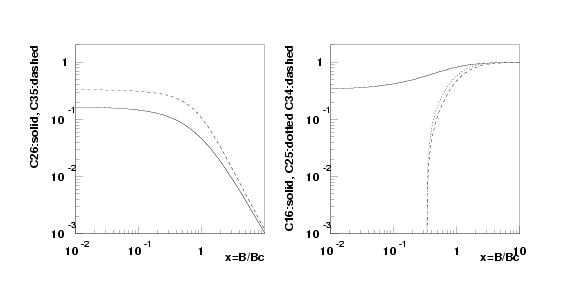Hi everybody,
I took a closer look at the details of wall depolarization and
found a solution to our Pz vs. Pzz mystery.
Wall depolarization in general is caused by well defined spin
flips that occur on the cell wall during a wall collision of
the particle. Well defined means that a transition occurs only
if the matrix element is non-zero and that certain selection
rules apply: delta m_F=0 or 1 and delta F=0 or 1. In our case
with a holding field of ca. 375Gauss, which is about 3.5 times
critical field, only the transitions 1-6, 2-5, and 3-4, as
well as 2-6 and 3-5 are of interest. The other five do not
contribute significantly.
The first attachment, coeff1.jpg, shows the matrix elements
of the five transitions. The so-called electron transitions
1-6, 2-5, and 3-4 (shown in the right picture) are very strong,
flip the electron spin but conserve vector and tensor polarization.
The two remaining transitions 2-6 and 3-5 (shown in the left
picture) are delta m_F=0 transitions (sigma transitions) and
reduce the vector and tensor polarization. They are not equal
in strength but follow the same field dependence: The higher
the field, the weaker the transition.
Here is why we have an asymmetry in the target vector and tensor
polarization:
The vector polarized target consist of
- vector plus: injected states 1 and 6,
- vector minus: injected states 3 and 4,
- tensor minus: injected states 2 and 5.
The two sigma transitons de-populate only one hyperfine level
in the case of the target vector states but both hyperfine
levels in the case of the target tensor minus state. The total
depolarizing effect is in first order twice as strong in the
tensor minus state than in each of the two target vector states.
I have attached a plot of an ABS calculation including all the
efficiencies etc. that shows a calculation that can reproduce
the measured polarization values within the error bars. The
effect of the three electron transitions is not shown in the
plots since it has no effect on the vector or tensor polarization.
I compared the calculation to the target polarization values
listed in Tancredi meeting minutes. The ABS tranitions are in
the range of 0.93-0.97. The simultaneous 2-6 and 3-5 transitions
do not produce a significant vector polarization in the tensor
state, just as observed, but different tensor polarizations
in the two vector states, 0.59 vs. 0.48. However, these two
values added up are close to the tensor minus value of 1.05.
The unpolarized background amounts to 0.07 of the total target.
This is a small contribution and is most probably due to the
fact that deuterium keeps polarized after it recombines. The
total amount of molecules in the target can therfore not be
estimated from the deuterium target. Also there is no difference
between vector and tensor polarization regarding depolarization
of the molecules. Both polarizations are effected equally if
depolarized in molecules (but that is just a side note).
Hauke


This archive was generated by hypermail 2.1.2 : Mon Feb 24 2014 - 14:07:31 EST